Here you’re going to find a lot of valuable information about SARMs and liver toxicity. We are going to answer the question: “Are SARMs Liver Toxic?” and generally, will talk about the hepatotoxicity of SARMs.
You’re going to find which ones are safer and how to use them safely. We’ll also talk about liver support that can greatly help you avoid any type of liver damage. Except for SARMs, we’re also going to talk about MK-677 (Ibutamoren), GW-501516 (Cardarine), and SR-9009 (Stenabolic) as these are common products that are used with SARMs. In fact, they are often categorized as SARMs too.
So well, in the end, a lot of people are wondering whether SARMs are hepatotoxic (liver toxic) such as damaging liver cells. Especially considering that SARMs come as liquids or tablets that you need to use orally. That’s something everyone should wonder before actually starting the administration of any compound.
Answer
As much as it looks, some of the liver enzymes are going to increase while you’re administering certain SARMs. How much exactly they are going to increase, of course, depends on the dosage and the cycle length (as well as SARM type). However, they are not going to cause liver damage and you’re extremely unlikely to experience any negative signs or symptoms as long as you’re a healthy individual, without pre existing health issues (especially liver issues) aged between 18 and 65 and using SARMs properly.
Therefore, as long as you’re healthy individual planning to use SARMs correctly, you’re very unlikely to experience any side effects to the liver. So there’s nothing to worry about.
While liver enzymes increase during the cycle, they tend to come back to normal after the cycle ends. That’s because some SARMs are actually liver toxic. But they are only mildly toxic, as many other drugs that you may administer without even knowing it.
 ALT and AST – Detecting Liver Toxicity
ALT and AST – Detecting Liver Toxicity
There are two types of liver enzymes – ALT (Alanine Transaminase) and AST (Aspartate Aminotransferase). If your liver is receiving some “damage” for whatever reason (such as consuming alcohol or some Over The Counter (OTC) medications, or many other compounds) these liver enzymes are released into the blood stream.
- These two enzymes are very important markers that allow us to determine how much your liver suffers at a given period. You should know that the ratio between these two liver enzymes should remain 4:5 ALT:AST.
- Moreover, blood test results for typical liver function tests include ALT ranging from 7 to 55 units per liter (U/L) and AST ranging from 8 to 48 U/L to be considered normal. Higher results mean that your liver isn’t in proper health.
The liver is an organ that can recover and heal itself. While it can take quite a good amount of damage and it can still recover, abusing something is never a good idea. That’s because it can lead to permanent liver damage. For example, when we’re consuming alcohol, ALT and AST levels increase. Most people know that. However, consuming too much alcohol and/or too often, can lead to serious liver damage such as cirrhosis, liver cancer, or liver failure.
By using SARMs in proper dosage and in proper cycle length, the liver can heal itself. But abusing these compounds, that’s likely to cause a lot of side effects, including liver damage.
Types And Causes of Liver Toxicity
Before we are going to share some more information about SARMs and liver damage, we must first share the relationship between the liver and the substances that are entering it.
There are three main ways that substances are causing liver toxicity and we’re going to share them here.

The first one is dose-dependent toxicity (high dosage). When you’re using too much of a substance (and/or for too long), your liver simply cannot purify all of the substance that you use in the period of time. It starts to increase in size and works even more intensively in an attempt to purify the substance. That’s why using a low dosage for a long period it’s sometimes not a problem as your liver can deal with it fast enough. That’s the main reason why I strongly recommend using SARMs in the lowest possible dosage. Especially considering that studies suggest SARMs are highly effective even in lower doses. Such as Ligandrol (LGD-4033), for example.
The second one is Drug Allergy. It happens very rarely. That’s when the immune system is attacking the substance and it happens in the liver. Therefore, it leads to liver inflammation and damage. Most commonly, you have other allergy symptoms so it’s easy to detect if you’re having allergies to a substance.
The third and the last one is occurring so rarely that it is barely worth mentioning. That’s Idiosyncratic Toxicity (a Genetic Deformation). It’s when the liver simply doesn’t purify the substance. It leads to accumulation and ultimately to toxicity in the liver. But then again, that’s so rare that it only happens in about 1 person out of 100,000.
Exercising and Liver Toxicity
According to studies, exercise increases fatty acid oxidation, decreases fatty acid synthesis, and is preventing mitochondrial as well as hepatocellular damage. Therefore, generally, physical exercises are helpful in improving your liver health.
However, it’s important to mention that a lot of people who are just starting to use SARMs are starting to work out seriously. That could lead to even more liver damage. How? Well, weightlifting results in increases in liver function tests in healthy men who were only used to moderate physical activity that did not include weightlifting. They have been staying high for about a week after weightlifting.
Generally, when our bodies are going through a lot of stress – liver enzymes increase. For example, marathon runners have different ALT and AST levels before and after a run.
- They tend to return to normal after a while, but it’s still very important for you to know that when you just start to work out – liver enzymes can increase. By combining them with SARMs – it can increase liver enzymes even more.
That’s one of the reasons why it’s best to work out and have a good diet months prior to starting the first SARMs cycle.

SARMs and Liver Toxicity
How do you know that the liver isn’t in the best condition? When you’re suffering from liver toxicity your skin and the whites of your eyes are turning yellow. These are the biggest signs of liver toxicity. Other signs that you may notice are loss of appetite and fatigue. But still, the yellowish eyes and skin are the biggest signs of liver disease. But in order to actually confirm that you’re suffering from liver toxicity, you need to go and check the liver enzymes.

If you’re using SARMs, you could have a test pre, during, and after cycle so you’ll have a great idea of how the SARMs are affecting your liver health.
I strongly recommend everyone to take all measures that could protect your liver:
- Avoid high dosages of SARMs
- Avoid alcohol and OTC meds or anything that could damage your liver
- Do not attempt overly high intensity exercises
- Add liver protection supplements that could lead keep it healthy
It’s important to know that some SARMs are more toxic than others. Nonetheless, I strongly recommend everyone to have natural liver support during any SARMs cycle.
Anyway, let’s check each SARM individually. We’re going to tell which are barely touching your liver and which are worse in this aspect.
Ostarine MK2866
Most people think of Ostarine as a mild SARM that is pretty safe. While it’s indeed safer than most other SARMs in terms of side effects, it’s still liver toxic. MK 2866 is especially liver toxic at higher dosages! That’s why, while you may think that Ostarine is safer, it’s best to have blood work before and after the Ostarine cycle.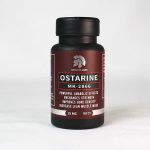
It’s almost impossible for this SARM to cause any issues, however. According to studies, ALT/ALS levels are not increasing to dangerous levels. However, remember that bodybuilders usually use much higher doses than those in studies. That’s why, while you’re unlikely to experience dangerous liver toxicity, you should still keep it safe.
People suffering from pre-existing liver issues and/or abusing Ostarine, however, are greatly increasing the chances of such issues occurring.
Ligandrol LGD4033
There’s just one study on LGD4033 in terms of liver enzymes and it shows that this SARM doesn’t increase ALT or ALS elevation. However, I’m not very sure if this study is enough to say that Ligandrol is not liver toxic at all.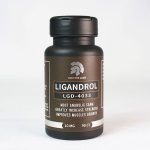
That’s because that study only used a maximum of 1 mg a day for only 21 days. That’s not enough considering that bodybuilders are using a Ligandrol cycle of 8 weeks and higher dosages.
Anyway, that study is still a good sign showing that even if LGD4033 turns out to actually increase ALT and ALS levels, it’s a very mild liver toxic SARM that’s very unlikely to cause serious issues to your liver in the 2 month cycle period.
RAD140 Testolone
According to many people who already tried RAD140 cycles – this is a non-liver toxic SARM. That’s because the blood work done by bodybuilders and athletes indicates it doesn’t increase ALT and AST levels.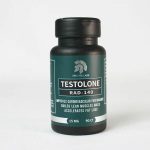
Nonetheless, remember that these are anecdotal evidence so we can’t have full trust in them.
Anyway, there are still a lot of people who have already tried Testolone and it doesn’t look like this SARM is causing any significant damage to the liver. We can assume that RAD 140 is not actually causing liver enzymes to spike in most people. But it’s still a good idea to keep your liver safe, just in case.
By the way, you could have blood work after each SARM cycle in order to determine if it has some impact on your liver health. Moreover, it could also determine whether you need a PCT plan by checking your hormone levels.
Andarine S4
 Andarine S4 is a SARM that is likely to increase enzyme levels in the liver. However, there are still zero reports of Andarine causing serious liver damage.
Andarine S4 is a SARM that is likely to increase enzyme levels in the liver. However, there are still zero reports of Andarine causing serious liver damage.
Instead, this is a powerful SARM that’s likely to cause other side effects. Especially in higher dosages and/or longer cycle lengths.
YK11
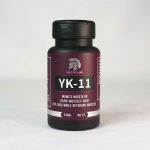 YK11 is a very powerful product that has an acid methyl ester. This makes it liver toxic because it’s in the “methylated” drugs category. Therefore, the liver toxicity risk is medium to high.
YK11 is a very powerful product that has an acid methyl ester. This makes it liver toxic because it’s in the “methylated” drugs category. Therefore, the liver toxicity risk is medium to high.
With this being said, by administering abnormal high dosages and/or long cycles – your liver enzymes are likely to spike to abnormally high levels.
I recommend being careful with YK11 and liver toxicity. Have liver support, short cycles, and low dosages to avoid getting permanent liver damage.
S23
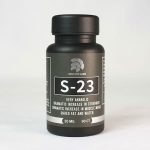 S23 is the strongest SARMs in existence, nonetheless, theoretically, it’s milder in terms of liver toxicity than YK11. That’s because S23 is not as methylated.
S23 is the strongest SARMs in existence, nonetheless, theoretically, it’s milder in terms of liver toxicity than YK11. That’s because S23 is not as methylated.
Some people may suggest that S23 is not liver toxic at all without chances of increasing liver enzymes, but I wouldn’t be so sure about that. It’s always best to check how it works for you with blood work before and after the S23 cycle as well as liver protection during the cycle. Especially because it’s very likely to be liver toxic.
MK677 Ibutamoren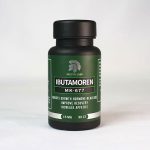
Ibutamoren is not actually a SARM and this could be the reason why Ibutamoren is actually not liver toxic at all. It’s safe for your liver and won’t cause any liver damage.
This is a secretagogue that is acting as a neuropeptide in the brain making your pituitary gland release more Growth Hormones.
Cardarine GW501516
 This is another compound that’s often seen as a SARM, but it’s actually a PPAR-delta agonist. Therefore, according to studies, Cardarine is actually helpful in reducing liver inflammation in animal studies. The data demonstrate that an orally active PPAR-delta agonist is having hepatoprotective as well as antifibrotic effects in the liver.
This is another compound that’s often seen as a SARM, but it’s actually a PPAR-delta agonist. Therefore, according to studies, Cardarine is actually helpful in reducing liver inflammation in animal studies. The data demonstrate that an orally active PPAR-delta agonist is having hepatoprotective as well as antifibrotic effects in the liver.
However, keep in mind that this study was performed on animals. It could work differently on humans. Using some form of liver protection is never a bad idea!
Stenabolic SR9009
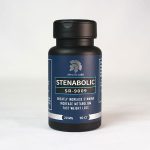 Stenabolic SR9009 is another compound that you can use without being worried about liver damage. It’s often classified as a SARM too, but it’s not. This is a Rev-erbA agonist. In fact, it’s another compound that, according to studies, can decrease liver fibrosis in mice.
Stenabolic SR9009 is another compound that you can use without being worried about liver damage. It’s often classified as a SARM too, but it’s not. This is a Rev-erbA agonist. In fact, it’s another compound that, according to studies, can decrease liver fibrosis in mice.
Pretty much exactly as with Cardarine, however, it’s never a bad idea to use a liver protecting supplement during any cycle.
What SARMs Are Liver Toxic?
In conclusion, I could say that Stenabolic SR9009, Cardarine GW501516, and MK677 Ibutamoren are very unlikely to cause any liver issues. They shouldn’t touch your liver or they might even help protect your liver.
On the other hand, we have YK11, S23, and Andarine S4 which can be pretty bad for your liver health. They are very likely to increase your liver enzymes. Therefore, I strongly recommend running these compounds with liver protection in low dosages and short cycles.
Lastly, we have Testolone RAD140, Ligandrol LGD4033, and Ostarine MK2866 which are likely to be mildly liver toxic. While liver enzymes can increase, they are unlikely to get too high in proper use.
SARMs Liver Support
Liver support is those supplements that can help you keep liver enzymes in the normal range. These products are popular for cleaning your liver, keeping it healthy, and for “assisting” your liver. Generally, liver support supplements are helpful in keeping your liver healthy.
That’s why I strongly recommend adding some liver supporting supplement during whatever SARMs cycle. They can help you prevent some damage to your liver during the cycle. Whenever you’re using something damaging to the liver, some liver support supplement is very welcome.
There are numerous different liver support supplements. Some of them include: TUDCA (Tauroursodeoxycholic acid), NAC (N-Acetyl Cysteine), Liv 52, Milk Thistle, N2Guard, and there are others as well.
There are numerous studies performed on numerous of these supplements (you can research them yourself) and they prove that they are highly effective in reducing both AST and ALT levels. They are protecting your liver.
For example, studies done on people suffering from hepatitis indicate that three months of usage of liver support could help lower enzyme levels by up to 50%! This means that by using liver support like NAC, TUDCA, or LIV 52 alongside SARMs, you’re going to protect your liver and prevent the increase of ALT and AST. You need to use liver support throughout the entire cycle and may even use it for a while after the cycle.
Some studies suggest that some SARMs are not only helpful at preventing liver damage, some of them are even helpful at recovering and healing the already existing liver damage.

Conclusion
In the end, some specific SARMs are more liver toxic than the others, while other SARMs are not toxic at all. However, I strongly recommend getting blood work done before, during, and after the cycle, especially after the first SARM cycle, to have a better idea of how those SARMs are affecting you. Moreover, I strongly recommend having a liver support supplement such as Milk Thistle, LIV 52, or TUDCA to add whenever you’re using SARMs to prevent some liver damage.
Generally, SARMs are not highly liver toxic, at least, far not as toxic as other compounds. Nonetheless, they are still posing a risk to your liver so it’s best to keep it safe. Especially if you’re already having high liver enzymes or liver damage pre-cycle. Also, keep cycle length and dosage within the normal range to avoid causing too much stress to your liver.
Generally, the chances of you experiencing some liver disease from the use of any SARMs are very and very low. It may occur only in case of abuse and/or having pre existing liver health issues. Nonetheless, it’s still important to know that chances are still present and SARMs can still increase your liver enzymes and stress your liver. So, keeping your organs safe is of utmost importance while running any kind of cycle.


